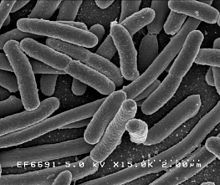Crevna flora
Crevna flora, crevna mikrobiota ili gastrointestinalna mikrobiota je kompleksna zajednica mikroorganizama koji žive u digestivnom traktu ljudi i drugih životinja, uključujući insekte. Crevni metagenom je agregat svih genoma crevnih mikrobiota.[1] Stomak je jedna od niša koje ljudska mikrobiota naseljava.[2]

Kod ljudi, crevna mikrobiota ima najveći broj bakterija i najveći broj vrste u poređenju sa drugim oblastima tela.[3] Kod ljudi se crevna flora uspostavlja nakon jedne do dve godine posle rođenja, i do tog vremena intestinalni epitel i intestinalna mukozna barijera koju on izlučuje su korazvijeni na način koji je tolerantan i čak podržava crevnu floru, i koji isto tako pruža barijeru za patogene organizme.[4][5]
Odnos između crevne flore i ljudi nije samo komensalan (vid neštetne koegzistencije), već je pre mutialistička relacija.[2]:700 Neki mikroogranizmi ljudskih creva koriste domaćinu putem fermentisanja dijetetskih vlakana u kratkolančane masne kiseline, kao što su sirćetna kiselina i buterna kiselina, koje zatim domaćin apsorbuje.[3][6] Intestinalne bakterije isto tako igraju ulogu u sintezi vitamina B i vitamina K, kao i u metabolizmu žučnih kiselina, sterola, i ksenobiotika.[2][6] Sistemski značaj kratkolančanih masnih kiselina i drugih jedinjenja poput hormona je takav da sama crevna flora funkcioniše kao endokrini organ,[6] i njena disregulacija je bila povezana inflamatornim i autoimunskim stanjima.[3][7]
Kompozicija ljudske crevne mikrobiote se menja tokom vremena, kad se menja ishrana, i u skladu sa promenama sveukupnog zdravlja.[3][7] Jedan sistematski pregled iz 2016. godine je ispitao preklinička istraživanja i ispitivanja na ljudima malog obima koja su sprovedena sa određenim komercijalno dostupnim sojevima probiotičkih bakterija i identifikovani su oni koji su imali najveći potencijal da budu korisni za određene poremećaje centralnog nervnog sistema.[8]
Reference
уреди- ^ Saxena, R.; Sharma, V.K (2016). „A Metagenomic Insight Into the Human Microbiome: Its Implications in Health and Disease”. Ур.: D. Kumar; S. Antonarakis. Medical and Health Genomics. Elsevier Science. стр. 117. ISBN 978-0-12-799922-7. doi:10.1016/B978-0-12-420196-5.00009-5.
- ^ а б в Sherwood, Linda; Willey, Joanne; Woolverton, Christopher (2013). Prescott's Microbiology (9th изд.). New York: McGraw Hill. стр. 713—21. ISBN 9780073402406. OCLC 886600661.
- ^ а б в г Quigley EM (2013). „Gut bacteria in health and disease”. Gastroenterol Hepatol (N Y). 9 (9): 560—69. PMC 3983973 . PMID 24729765.
- ^ Sommer F, Bäckhed F (2013). „The gut microbiota – masters of host development and physiology”. Nat Rev Microbiol. 11 (4): 227—38. PMID 23435359. doi:10.1038/nrmicro2974.
- ^ Faderl M; et al. (april 2015). „Keeping bugs in check: The mucus layer as a critical component in maintaining intestinal homeostasis”. IUBMB Life. 67 (4): 275—85. PMID 25914114. doi:10.1002/iub.1374.
- ^ а б в Clarke G; et al. (avgust 2014). „Minireview: Gut microbiota: the neglected endocrine organ”. Mol Endocrinol. 28 (8): 1221—38. PMC 5414803 . PMID 24892638. doi:10.1210/me.2014-1108.
- ^ а б Shen S, Wong CH (2016). „Bugging inflammation: role of the gut microbiota”. Clin Transl Immunology (Review). 5 (4): e72. PMC 4855262 . PMID 27195115. doi:10.1038/cti.2016.12.
- ^ Wang H, Lee IS, Braun C, Enck P (jul 2016). „Effect of probiotics on central nervous system functions in animals and humans – a systematic review”. J. Neurogastroenterol Motil. 22 (4): 589—605. PMC 5056568 . PMID 27413138. doi:10.5056/jnm16018. „We reviewed the effect of probiotics on the central nervous system in randomized controlled trials in animals and humans, and analyzed the possibility of translating animal models to human studies because few human studies have been conducted to date. According to the qualitative analyses of current studies, we can provisionally draw the conclusion that B. longum, B. breve, B. infantis, L. helveticus, L. rhamnosus, L. plantarum, and L. casei were most effective in improving CNS function, including psychiatric disease-associated functions (anxiety, depression, mood, stress response) and memory abilities.”
Literatura
уреди- Maranduba, CM; De Castro, SB; de Souza, GT; Rossato, C; da Guia, FC; Valente, MA; Rettore, JV; Maranduba, CP; de Souza, CM; do Carmo, AM; Macedo, GC; Silva, FS (2015). „Intestinal Microbiota as Modulators of the Immune System and Neuroimmune System: Impact on the Host Health and Homeostasis”. Journal of Immunology Research. 2015: 931574. PMC 4352473 . PMID 25759850. doi:10.1155/2015/931574.
- De Preter, Vicky; Hamer, Henrike M; Windey, Karen; Verbeke, Kristin (2011). „The impact of pre- and/or probiotics on human colonic metabolism: Does it affect human health?”. Molecular Nutrition & Food Research. 55 (1): 46—57. PMID 21207512. doi:10.1002/mnfr.201000451.
- Prakash, Satya; Rodes, Laetitia; Coussa-Charley, Michael; Tomaro-Duchesneau, Catherine; Tomaro-Duchesneau, Catherine; Coussa-Charley; Rodes (2011). „Gut microbiota: Next frontier in understanding human health and development of biotherapeutics”. Biologics: Targets and Therapy. 5: 71—86. PMC 3156250 . PMID 21847343. doi:10.2147/BTT.S19099.
- Wu, G. D.; Chen, J.; Hoffmann, C.; Bittinger, K.; Chen, Y.-Y.; Keilbaugh, S. A.; Bewtra, M.; Knights, D.; Walters, W. A.; Knight, R.; Sinha, R.; Gilroy, E.; Gupta, K.; Baldassano, R.; Nessel, L.; Li, H.; Bushman, F. D.; Lewis, J.D. (2011). „Linking Long-Term Dietary Patterns with Gut Microbial Enterotypes”. Science. 334 (6052): 105—08. Bibcode:2011Sci...334..105W. PMC 3368382 . PMID 21885731. doi:10.1126/science.1208344.